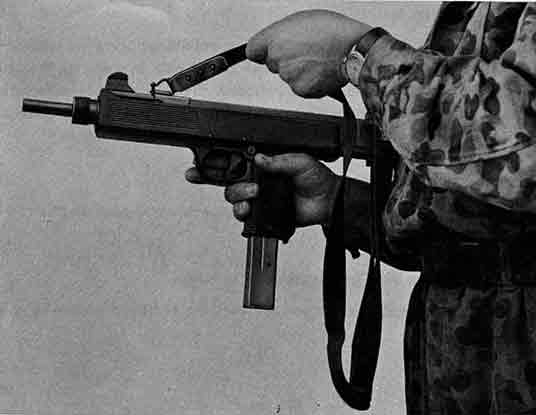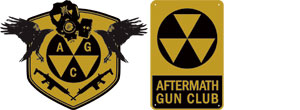The Steyr MPi69 was developed in the late 1960’s and adopted by the Austrian military in 1969. Production slowed after the introduction of the sub-caliber AUG SMG and eventually discontinued entirely in 1990 with the introduction of the Steyr TMP.

© Atirador
The MPi69 is a straight blowback operated weapon which fires from an open-bolt.
The receiver is made from light-gauge stamped steel which is welded into a box shape with an extra opening forward (76 mm) of the ejection port for an insert. This insert secures the barrel seating, retaining (ca)p nut, and retaining nut locking assembly. The barrel can be removed by hand pressing in the locking assembly button and spinning the cap nut off, followed by the barrel.
The Steyr is shaped much like other telescoping bolt SMG’s including the Uzi. The handguard area is horizontally extended for more real estate. The markings are on top of the receiver with the serial number also pressed into the polymer frame.
The receiver cover (frame) and pistol grip are made from nylon, which partially covers the right side, left side, and bottom of the steel receiver. The bolt is of a sleeving or overhung type and contains a fixed firing pin. This type of bolt puts a lot of mass forward of the breech on firing. This improves the handling in full-auto, the balance, as well as shortening the overall length. Further shortening is accomplished with a telescopic stock made from steel wire.
The ten inch barrel is cold hammer forged on a rifling mandrel which provides improved grooves over button rifling. Both the inner and outer skins of the barrel are work-hardened.
The cocking slide is located at the left and also used as a front swivel. In order to pull the charging handle back, the sling must be pulled at a right angle to disengage the cocking slide catch from the front sight. the sling can now be pulled rearward to charge the weapon. For some ethos, while some disliked this peculiar sling-charger, Ian Hogg described the SMG as excellent.

The magazine release is in the heel of the pistol-grip, it has a vertical pistol grip which contains the magazine well. The steel magazines come in 25 and round capacities and were designed specifically for this weapon.
The safety has three positions in the form of a cross bar located above and behind the trigger. The cross-bolt safety is marked S in white on the right. When pushed left to the middle position the firearm is in semi-auto mode. When pushed all the way left (marked with a red F) the firearm will still fire only one round when pressing the trigger slightly back and will fire full-auto when pulled all the way rearward in this position. Those familiar with the AUG series of rifles will be familiar with this safety.
Internally there are also three sear positions for additional safety. If the main sear fails to engage, this design prevents the bolt from going forward and firing a shot. This prevents slam fire in case the cocking piece is released before locking to the rear open-bolt position. This design would also prevent low powered rounds, which fail to cycle the bolt to the necessary rearward position, from continuing to fire in full auto (which would be a surprise if the trigger were already released).
A silencer conversion was made which required swapping the barrel and replacing the barrel retaining nut with a proprietary suppressor that performs the dual role of securing the barrel. There are also two variants, the MPi81 with a faster cyclic rate of 700 rpm (vs 550 rpm) and the MPi81 “Loop Hole” model meant to be used as a port firing weapon with an AUG optic and longer barrel with a fitting for port mounting.
Pre-1968 registered NFA firearms do exist but are not common. Dealer samples have been seen for sale each time I’ve looked (2006-2014).
From ID.GUN.FM.
